Biotope Map Creation Method and Utilization Plan for Eco-Friendly Urban Development
Abstract
1. Introduction
2. Materials and Method
2.1. Site Selection in Previous Studies
2.2. Biotope Meso-Classification Type Evaluation Grades for Previous Study Sites
2.3. Naturality Categorization for Each Biotope Meso-Classification Type Evaluation Grade
- (1)
- Nature: Nature refers to an original ecosystem with significant value or potential as a biological habitat. It falls under the meso-classification biotope evaluation Grade 1, necessitating absolute preservation due to the absence of anthropogenic disturbance or long-term stability.
- (2)
- Near-nature: Near-nature characterizes an area with low intensity of land use and a close proximity to natural conditions. This category corresponds to meso-classification biotope evaluation Grades 2 and 3. Near-nature biotopes experience human interference and are sensitive to damage. However, they possess a certain level of naturality and a high potential for enhancing their ecological value through restoration efforts.
- (3)
- Semi-nature: Semi-nature denotes areas constantly affected by human interference and influence. These areas can be classified as a form of human-created nature. Semi-nature biotopes are examples of meso-classification biotope evaluation Grades 4 and 5. Their potential for regeneration into natural ecosystems is low. They exhibit excessive energy utilization and disconnected circulation systems.
2.4. Management Objectives Based on Naturality Category
2.5. Biotope Meso-Classification Type Evaluation Criteria with Management Goals
2.6. Biotope Minor-Classification Type Evaluation Indicators
2.7. Biotope-Type Classification and Evaluation Method
2.8. Application to the Study Site
3. Results
3.1. Biotope Types and Evaluation Results for Dongducheon City
3.2. Detailed Results of Biotopes in Urbanized Areas according to Management Goals
3.3. Specific Results of Biotopes in Green Areas According to Management Goals
3.4. Creation of Thematic Maps Using Biotope Minor-Classification Types
4. Discussion
5. Conclusions
Author Contributions
Funding
Data Availability Statement
Conflicts of Interest
References
- Keller, D.R.; Golley, F.B. The Philosophy of Ecology: From Science to Synthesis; University of Georgia Press: Athens, GA, USA, 2000; p. 114. [Google Scholar]
- Sukopp, H.; Weiler, S. Biotope mapping and nature conservation strategies in urban areas of the Federal Republic of Germany. Landsc. Urban Plan. 1988, 15, 39–58. [Google Scholar] [CrossRef]
- Schaefer, M. Ökologie. In Wörterbücher der Biologie, 3rd ed.; Gustav Fischer: Stuttgart, Germany, 1988; p. 433. [Google Scholar]
- Hwa, R.J. A study on the urban mapping (UBM) and a building of biotope information system (BIS) as a specialized tool in urban landscape planning. J. Korean Inst. Trad. Landsc. Archit. 1997, 15, 133–145. [Google Scholar]
- Arbeitsgruppe Methodik der Biotopkartierung im besiedelten Bereich. Flächendeckende Biotopkartierung im besiedelten Bereich als Grundlage einer am Naturschutz orientierten Planung. Programm für die Bestandsaufnahme, Gliederung und Bewertung des besiedelten Bereichs und dessen Randzonen. Nat. Landsch. 1993, 68, 492–526. [Google Scholar]
- Blab, J.; Riecken, U.; Ssymank, A. Proposal on a criteria system for a National Red Data Book of Biotopes. Landsc. Ecol. 1995, 10, 41–50. [Google Scholar] [CrossRef]
- Spellerberg, I.F. Evaluation and Assessment for Conservation: Ecological Guidelines for Determining Priorities for Natural Conservation; Champman & Hall: London, UK, 1992; p. 260. [Google Scholar]
- Ratcliffe, D.A. A Nature Conservation Review; Cambridge University Press: Cambridge, UK, 1977; Volume 1, pp. 6–10. [Google Scholar]
- Auhagen, A.; Sukopp, H. Ziele, Begründungen und Methoden des Naturschutzes im Rahmen der Stadtentwicklungspolitik von Berlin. Nat. Landsch. 1983, 58, 9–15. [Google Scholar]
- Johnston, J. Nature Areas for City People. A Guide to the Successful Establishment of Community Wildlife Sites; Ecology Handbook 14; London Ecology Unit: London, UK, 1990; p. 116. [Google Scholar]
- Plachter, H. Methodische Rahmenbedingungen für synoptische Bewertungsverfahren im Naturschutz. Z. Ökol. Naturschutz. 1994, 3, 87–106. [Google Scholar]
- Marsh, S. Nature Conservation in Community Forests; Ecology Handbook 23; London Ecology Unit: London, UK, 1994; p. 64. [Google Scholar]
- Caldecott, J.O.; Jenkins, M.D.; Johnson, T.; Groombridge, B. Priorities for Conserving Global Species Richness and Endemism; World Conservation Monitoring Centre (WCMC) Biodiversity Series No. 3; World Conservation Press: Cambridge, UK, 1994; p. 36. [Google Scholar]
- Dierßen, K.; Roweck, H. Bewertung im Naturschutz und in der Landschaftsplanung. In Integrative Umweltbewertung; Theorie und Beispiele aus der Praxis; Theobald, W., Ed.; Springer: Berlin/Heidelberg, Germany, 1998; pp. 175–192. [Google Scholar]
- Choi, S. Study of Environmental Impact Assessment Techniques for Forest Ecosystems: Focus on the Evaluation of the Naturality of Green Spaces. Ph.D. Thesis, Graduate School of University of Seoul, Seoul, Republic of Korea, 1996; p. 149. [Google Scholar]
- Kwon, J. A Study on the Ecological Evaluation for the Nature-Friendly Residential Site Development Planning. Ph.D. Thesis, Graduate School of University of Seoul, Seoul, Republic of Korea, 2003; p. 281. [Google Scholar]
- Kim, J. Ecological Land Use Planning Considering the Characteristics of Urban Ecosystem: A Case Study of Hanam, Kyeonggi Province. Ph.D. Thesis, Graduate School of University of Seoul, Seoul, Republic of Korea, 2005; p. 271. [Google Scholar]
- Choi, J. Development of Classification and Evaluation Process of Biotope Type by Suitable Regional Characteristics in Seoul. Ph.D. Thesis, Graduate School of University of Seoul, Seoul, Republic of Korea, 2009. Metropolitan Area: Korea. pp. 161–162. [Google Scholar]
- Seoul Metropolitan Government. Biotope Status Survey and Establishment of Ecological City Creation Guidelines for Application of Urban Ecology Concept to Urban Planning for Seoul; Seoul Metropolitan Government: Seoul, Republic of Korea, 2001. [Google Scholar]
- Kim, H.; Lee, Y.; Choi, J.; Kwon, H. A Study of the Creation and Operation Method of Urban Ecological Maps for Basic Local Governments in Gyeonggi Province; Gyeonggi Research Institute: Pangyo, Republic of Korea, 2020; p. 135. [Google Scholar]
- National Institute of Ecology. Natural Environment Survey-Related System and Operation Casebook of Germany; National Institute of Ecology: Seocheon County, Republic of Korea, 2019. [Google Scholar]
- Song, I. Environmentally Friendly Urban Management Using Biotope Maps; The Seoul Institute: Seoul, Republic of Korea, 2016; p. 2. [Google Scholar]
- Ministry of the Environment. Guidelines on How to Create an Urban Ecological Map; Ministry of the Environment: Sejong, Republic of Korea, 2021; p. 19. [Google Scholar]
- Sukopp, H.; Kunick, W.; Schneider, C. Biotope mapping in the built-up areas of West Berlin. Part II. Field methods and evaluation. Gart Landsch. 1980, 7, 565–569. [Google Scholar]
- Cairns, J., Jr. Is restoration ecology practical? Restor. Ecol. 1993, 1, 3–7. [Google Scholar] [CrossRef]
- Kim, H. Classification Biotope Type and Evaluation Value of Individual Biotope: Landscape Ecological Approaches. Ph.D. Thesis, Graduate School of Dongguk University, Seoul, Republic of Korea, 2012; p. 46. [Google Scholar]
- Siheung City. Service for Ecological Survey and Urban Ecological Map Creation; Siheung City Council: Siheung, Republic of Korea, 2020; pp. 147–171. [Google Scholar]
- Goyang City. Urban Ecological Map Reorganization Service for Goyang City; Goyang City Council: Goyang, Republic of Korea, 2022; pp. 207–218. [Google Scholar]
- Gwangju City. Academic Service for Creating Gwangju City Urban Ecological Map; Gwangju City Council: Gwangju, Republic of Korea, 2021; pp. 303–311. [Google Scholar]
- Pyeongtaek City. Service for Pyeongtaek City Urban Ecological Map Creation and Web GIS System Construction; Pyeongtaek City Council: Pyeongtaek, Republic of Korea, 2021; pp. 262–274. [Google Scholar]
- Hwaseong City. Service for Hwaseong City Ecological Urban Map Creation; Hwaseong City Council: Hwaseong, Republic of Korea, 2021; pp. 241–252. [Google Scholar]
- Guri City. Research Service for Creating Guri City Urban Ecological Map; Guri City Council: Guri, Republic of Korea, 2022; pp. 266–275. [Google Scholar]
- Knickrehm, B.; Rommel, S. Biotoptypenkartierung in der Landschaftsplanung. Anforderungen an Einen Kartierschlüssel vor dem Hintergrund der Lokalen Landschaftserfassung. Bachelor’s Thesis, Leibniz University of Hanover, Hannover, Germany, 1994; p. 169. [Google Scholar]
- Cho, D. Concept and Considerations of Ecological Restoration. 1990, p. 34. Available online: https://search.naver.com/p/crd/rd?m=1&px=408&py=216&sx=408&sy=216&p=iCf5twpzLiwssvCzd1ZssssstsC-253891&q=%EC%83%9D%ED%83%9C%EB%B3%B5%EC%9B%90%EC%9D%98+%EA%B0%9C%EB%85%90%EA%B3%BC+%EA%B3%A0%EB%A0%A4%EC%82%AC%ED%95%AD&ie=utf8&rev=1&ssc=tab.nx.all&f=nexearch&w=nexearch&s=%2BKfPVsyv6RqwSa3belyiow%3D%3D&time=1715767562645&abt=%5B%7B%22eid%22%3A%22PTC-DEL-FEAT%22%2C%22vid%22%3A%226%22%7D%5D&a=web_gen*w.pdf&r=0&i=a00000fa_c5e090857a7c6e2196b711d0%5EDG&u=http%3A%2F%2Fwww.koreascience.or.kr%2Farticle%2FJAKO200251922814768.pdf&cr=1 (accessed on 13 May 2024).
- Seoul Metropolitan Government. Measures to Promote Biodiversity per Biotope Type for Seoul; Seoul Metropolitan Government: Seoul, Republic of Korea, 2004. [Google Scholar]
- Kim, G.; Jo, D. Principles of Natural Environment and Ecological Restoration; Academy Book: Seoul, Republic of Korea, 2004. [Google Scholar]
- Lee, E. A Planning for Substitute Habitats by the Habitat Types in Urban. Acad. Present. Pap. Korean Soc. Plant Environ. Des. 2008, 129–131. [Google Scholar]
- Bradshaw, A.D. The biology of land restoration. In Applied Population Biology; Jain, S.K., Botsford, J.W., Eds.; Kluwer Academic Publishers: Dordrecht, The Netherlands, 1992; pp. 25–44. [Google Scholar]
- Seoul Development Institute. A Detailed Survey Study on Excellent Ecosystem Areas in Seoul; Seoul Metropolitan Government: Seoul, Republic of Korea, 2001; p. 641. [Google Scholar]
- Ministry of the Environment. Urban Ecological Map Creation Manual; Ministry of the Environment: Sejong, Republic of Korea, 2019; p. 3. [Google Scholar]
- Hansson, L.; Angelstam, P. New ecological processes in small reserves. In Nature Conservation; Svensson, L., Ed.; National Swedish Environmental Protection Board, Research Secretariat: Solna, Sweden, 1988; pp. 25–32. [Google Scholar]
- Kim, J.H.; Na, J.H.; Lee, S.J.; Gwon, O.S.; Lee, E.J. Analysis of Green Spaces Biotope Fragmentation Patterns in Daejeon Metropolitan City via Landscape Indexes and Visualization Techniques. J. Korean Soc. Environ. Restor. Technol. 2016, 19, 29–44. [Google Scholar] [CrossRef][Green Version]
- Jeon, S.-W.; Hwang, J.-H.; Jang, R.-I. A Study on the Estimation Method of Carbon Storage Using Environmental Spatial Information and InVEST Carbon Model: Focusing on Sejong Special Self-Governing City—Using Ecological and Natural Map, Environmental Conservation Value Assessment Map, and Urban Ecological Map. J. Korea Soc. Environ. Restor. Technol. 2022, 25, 15–27. [Google Scholar]
- Kim, Y.M.; An, S.M.; Moon, S.Y.; Kim, H.S.; Jang, D.H. Wind corridor analysis and climate evaluation with Biotop map and airborne LiDAR data. J. Korean Instit. Landsc. Architect. 2012, 40, 148–160. [Google Scholar] [CrossRef][Green Version]
- Chae, J.H.; Koo, T.H. Development of Biotope evaluation indexes for improving bird diversity. J. Environ. Policy 2005, 4, 113–127. [Google Scholar]
- Han, B.H.; Choe, J.U.; Kim, J.S.; No, T.H. A study of Wildbird habitat characteristics on Biotope type of stream—In case of Seom River and Wonju stream, Wonju. Acad. Present. Pap. Korean Soc. Environ. Ecol. 2009, 2, 177–181. [Google Scholar]
- Kim, J.H.; Yoon, Y.H.; Joo, C.H. Biotope Map Utilization Plan for Urban Management in Response to Climate Change Impacts (1): Analysis of thermal environment change factors per biotope type. Acad. Present. Pap. Korean Environ. Sci. Soc. 2011, 20, 477–478. [Google Scholar]
- Kang, D.H.; Park, I.H.; Kim, J.H.; Lee, S.J.; Kwon, O.S. Ecosystem service valuation on groundwater storage capacity by Biotope type. J. Korea Soc. Environ. Restor. Technol. 2017, 20, 1–13. [Google Scholar]
- Yoon, Y.-H.; Joo, C.-H.; Kim, J.-H. Improvement of environmental comport by land-use using bioclimatic chart. J. Korean Reg. Dev. Assoc. 2011, 23, 39–58. [Google Scholar]
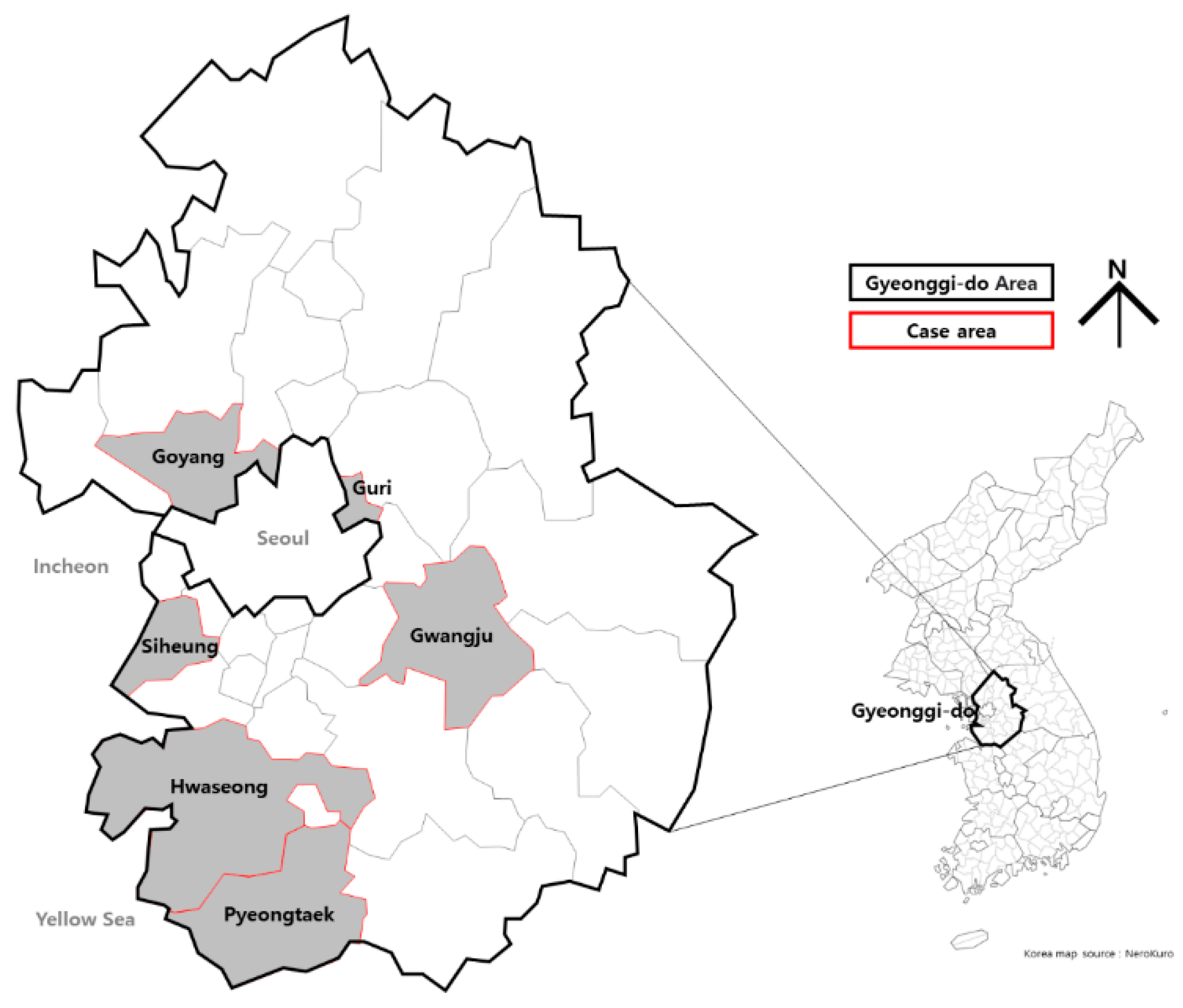
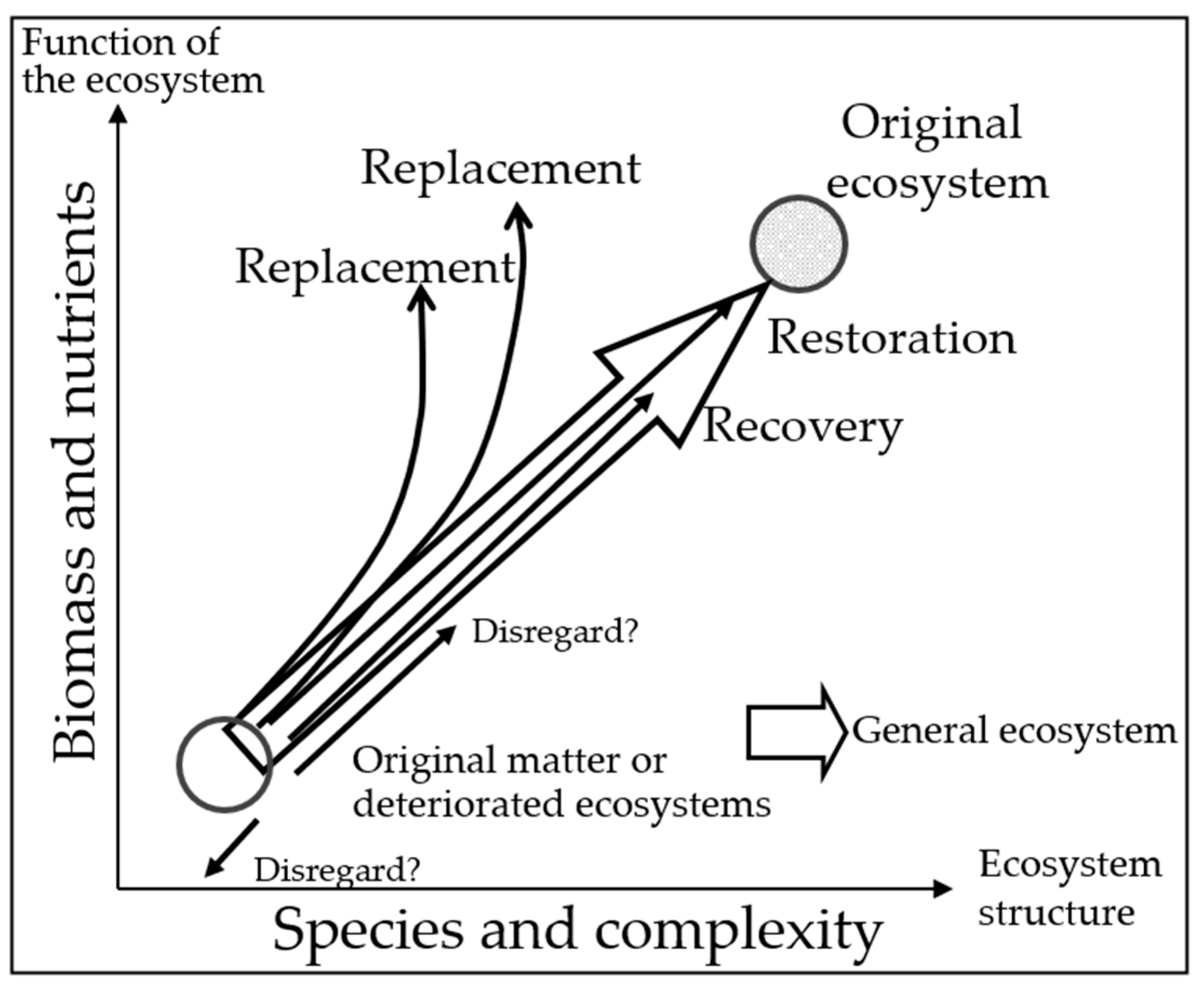
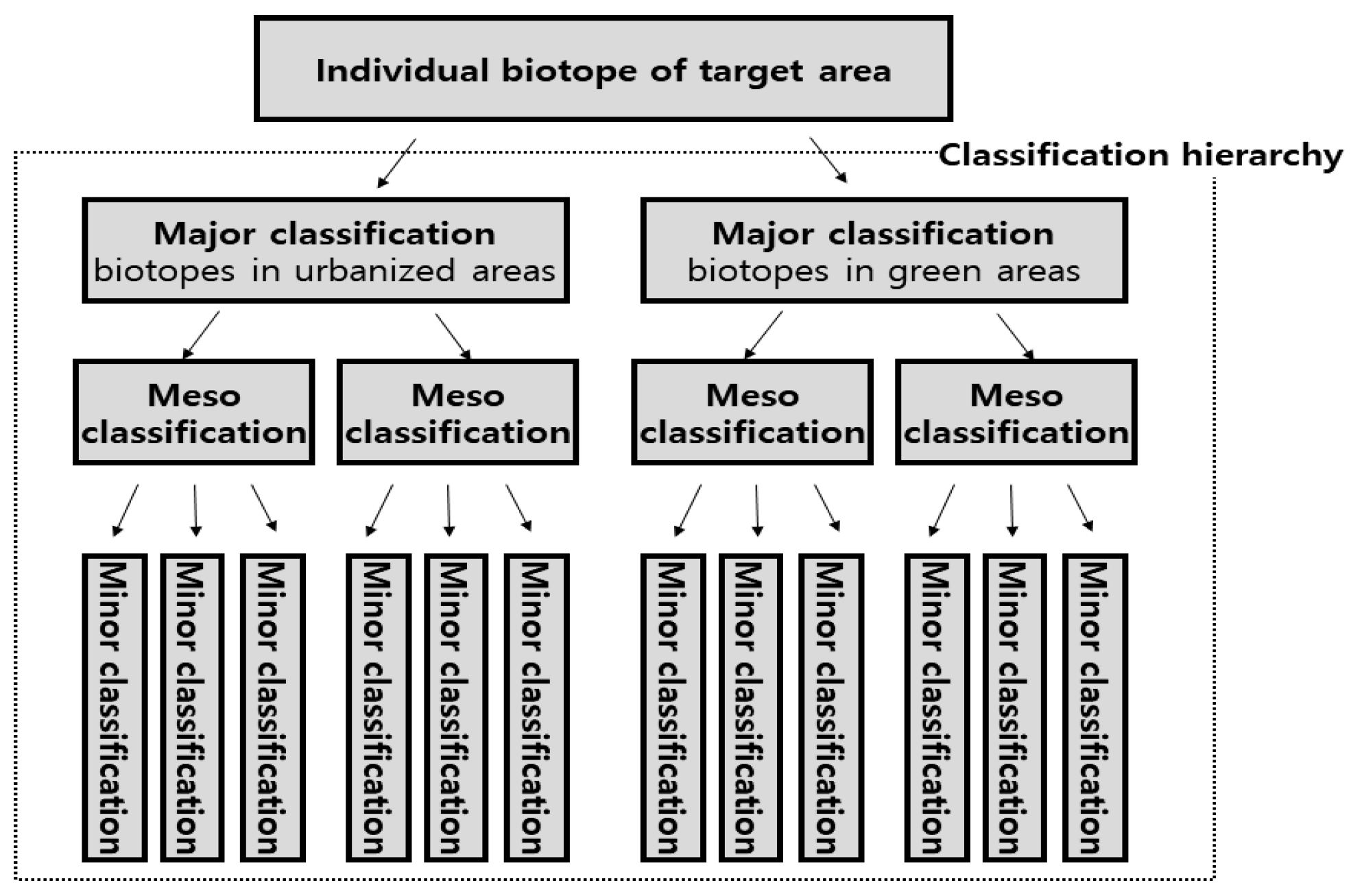

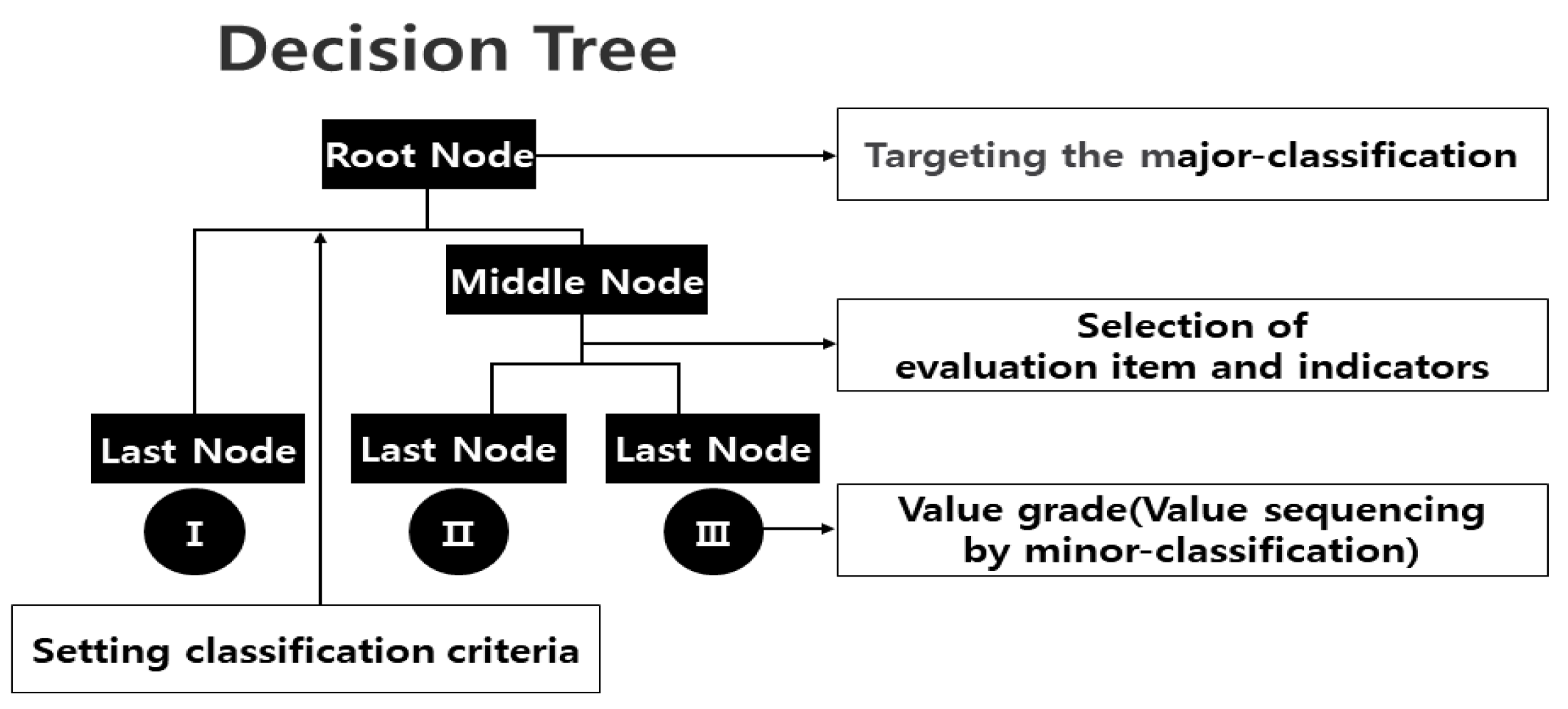

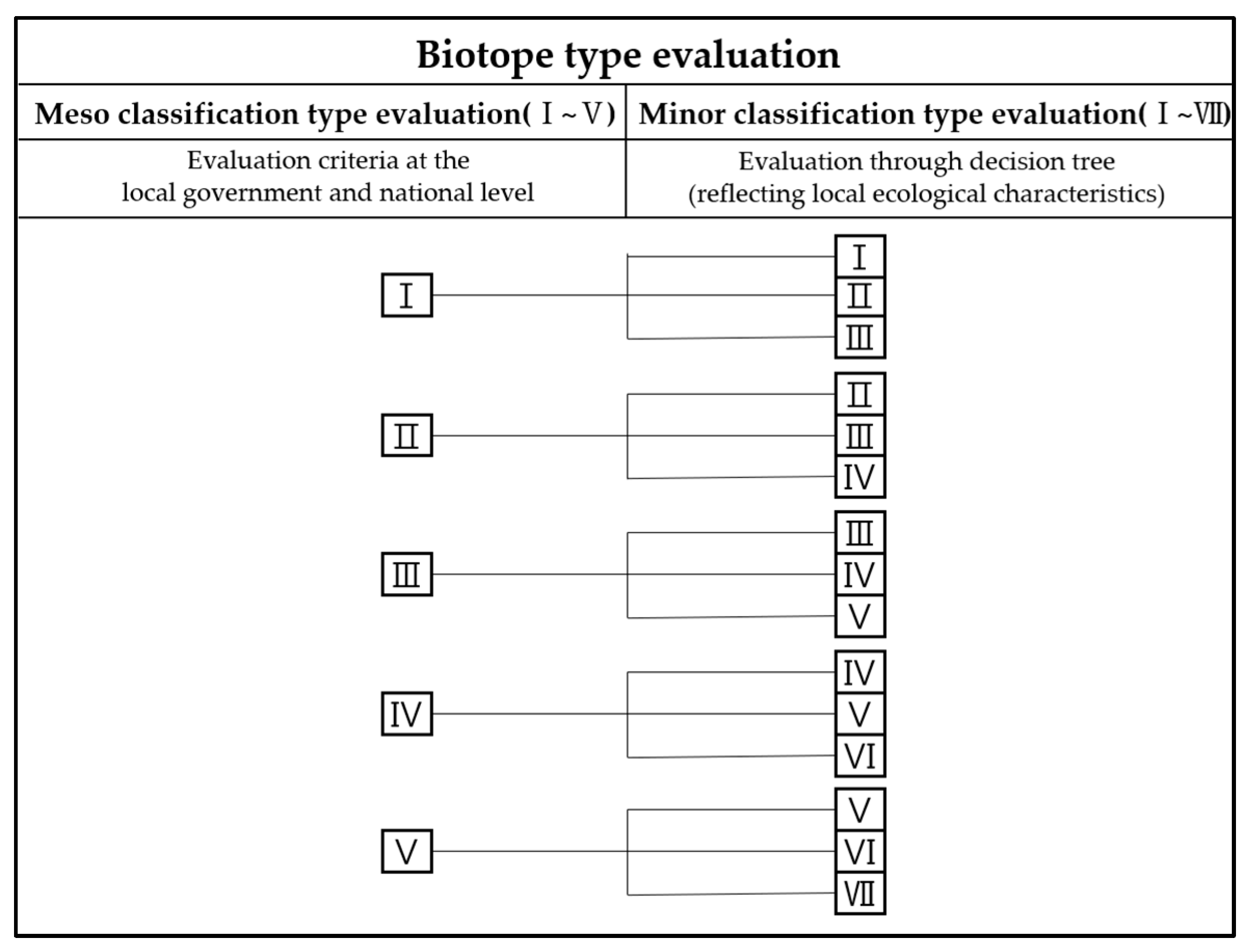

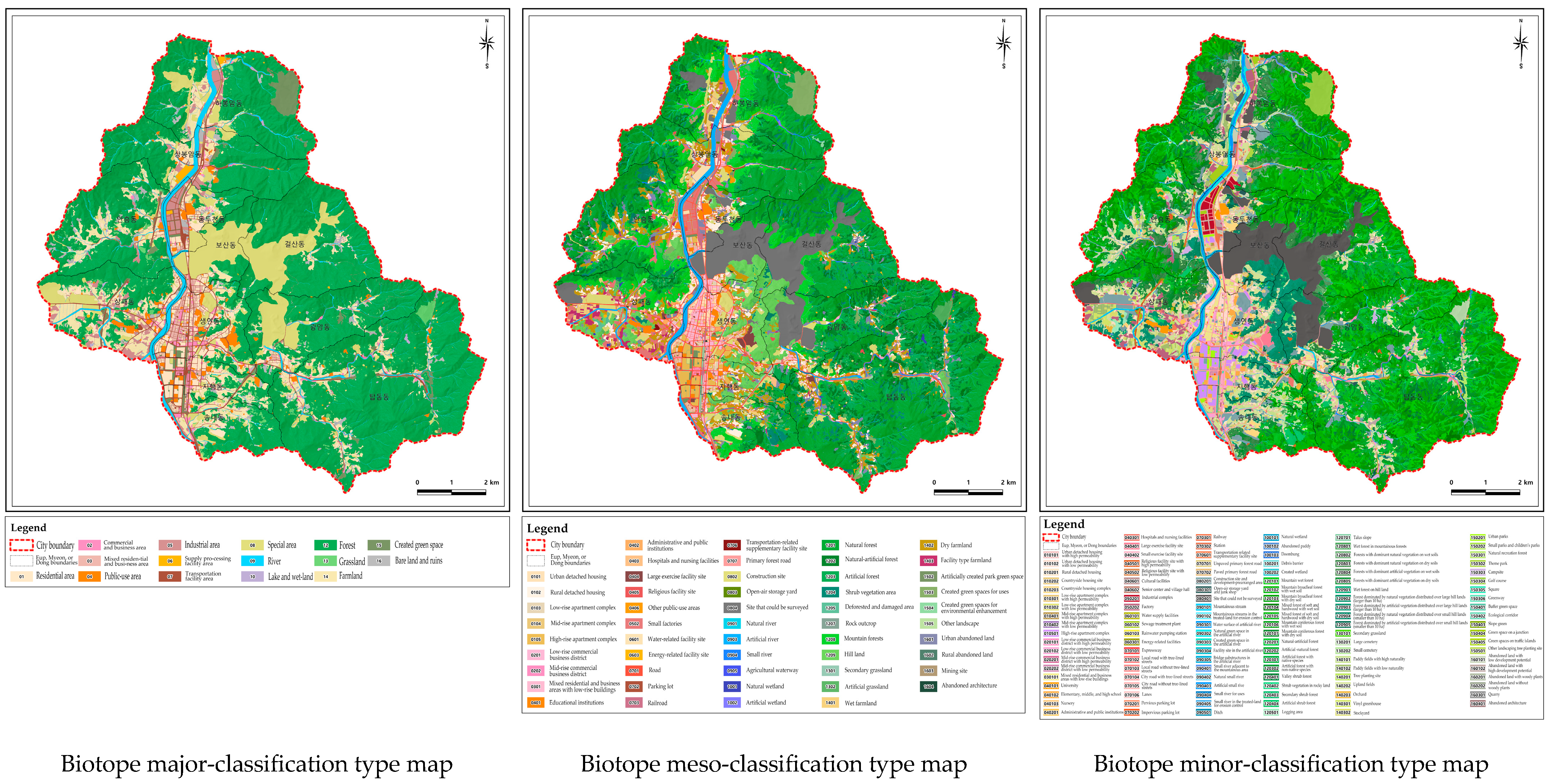
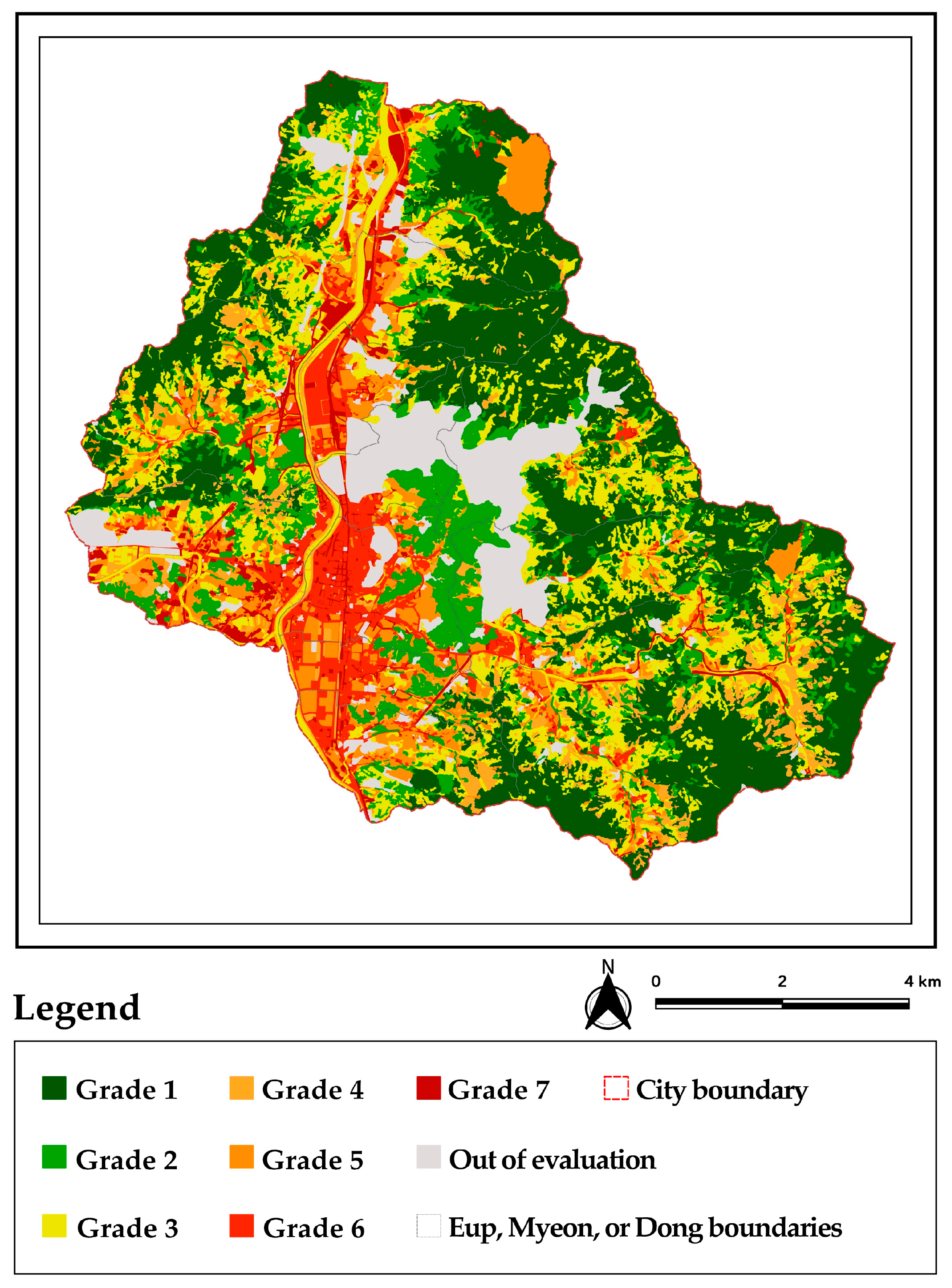


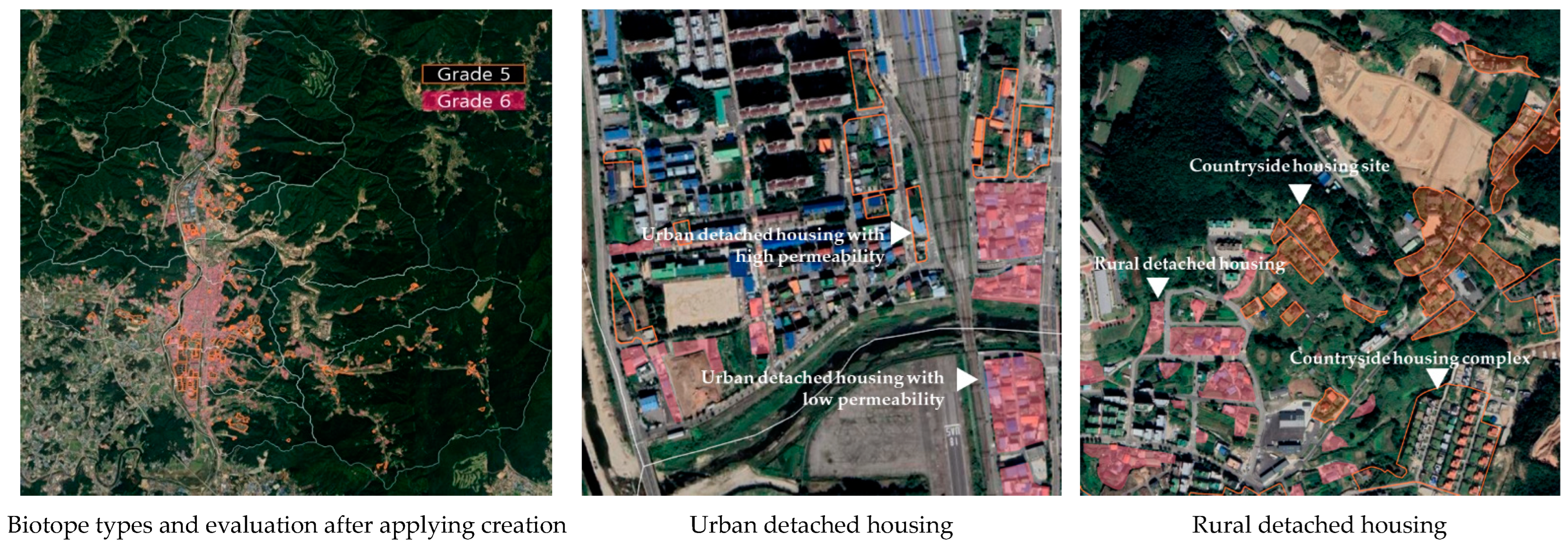
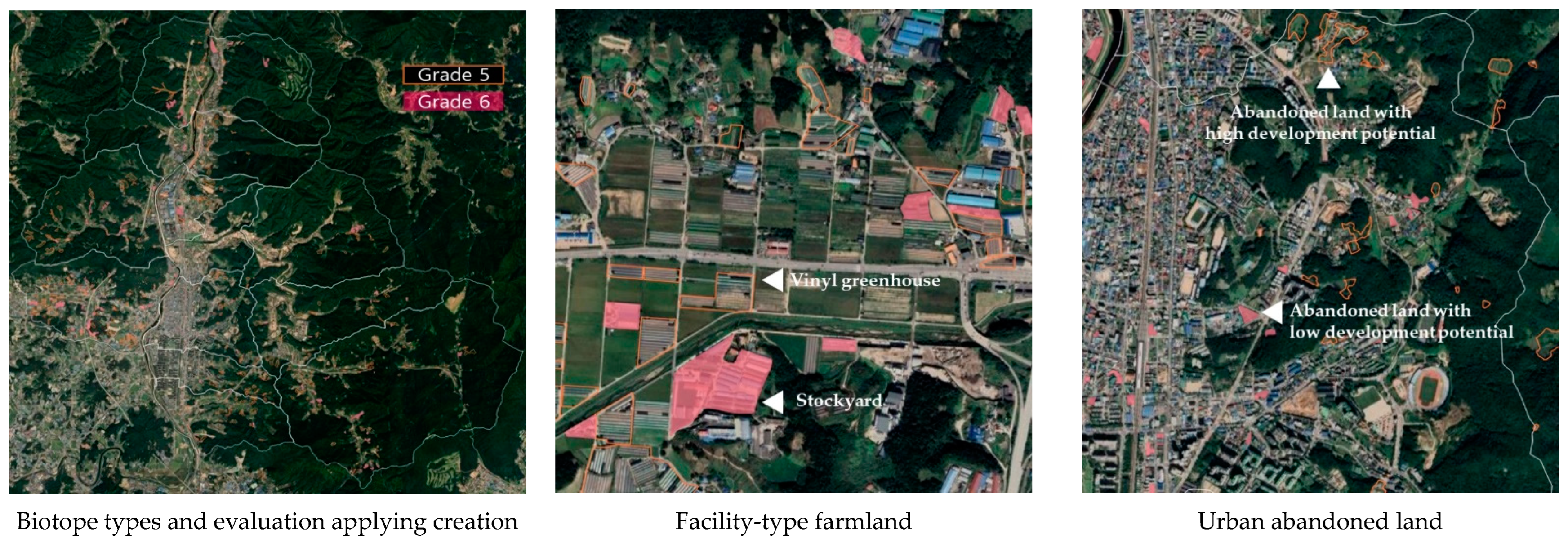
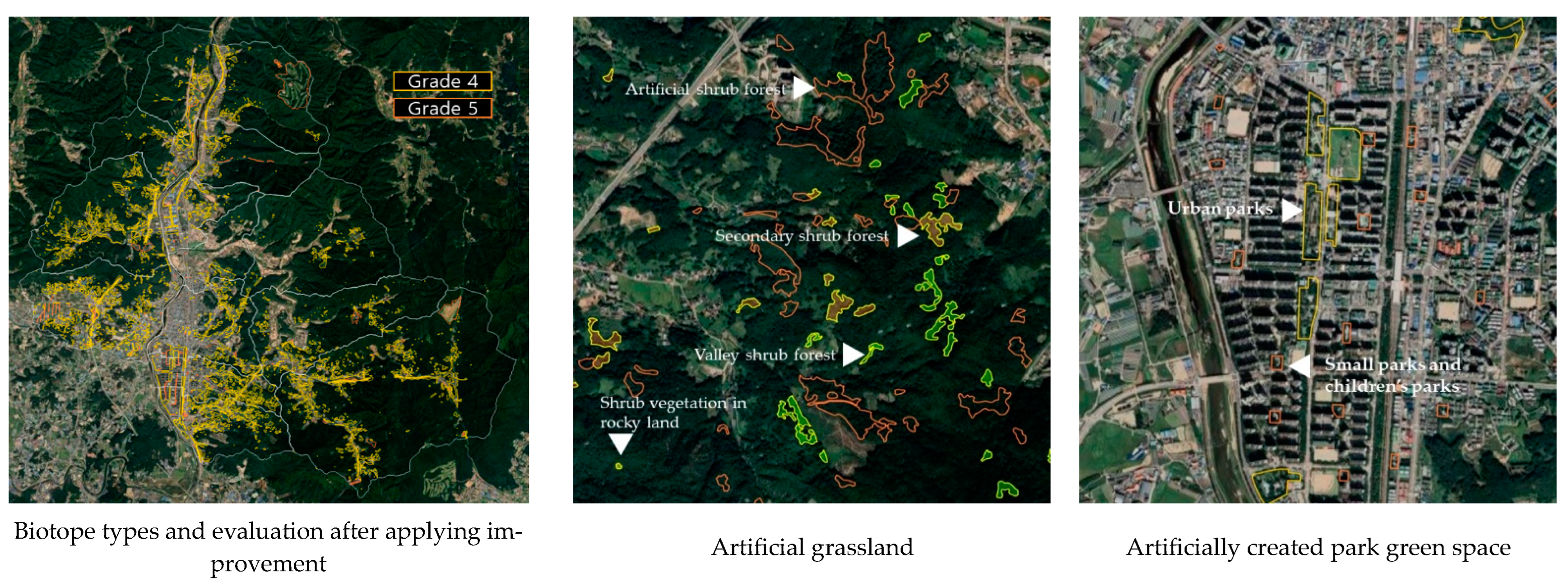
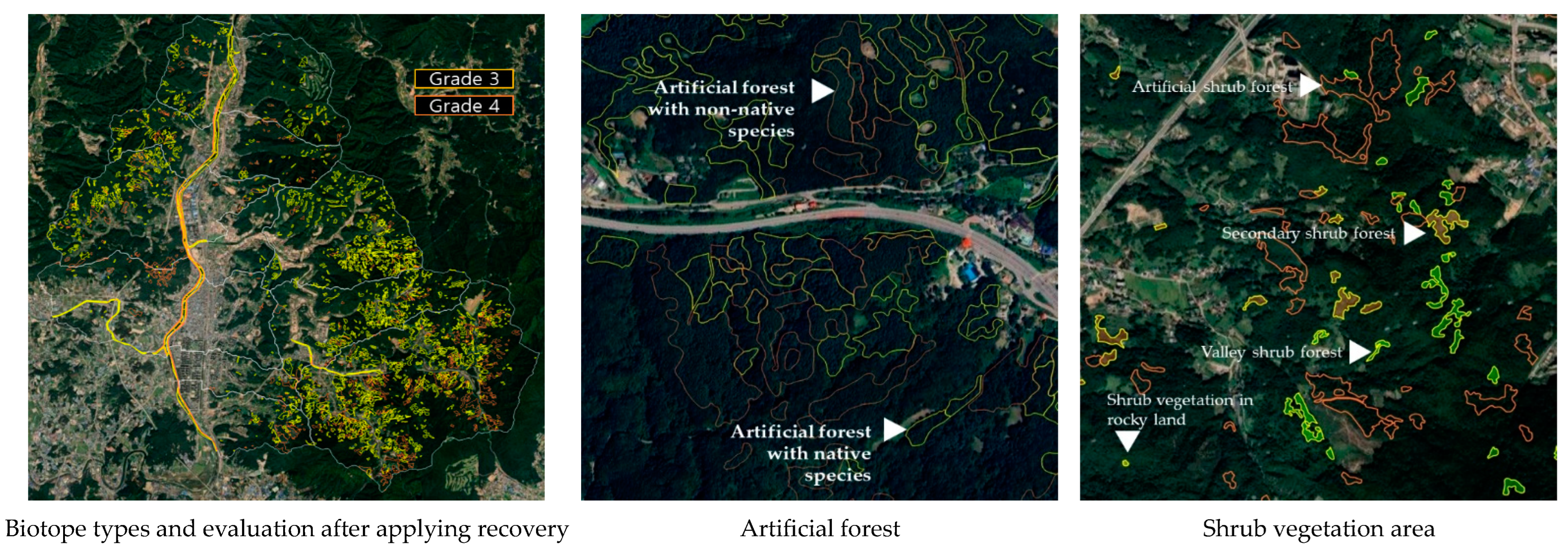
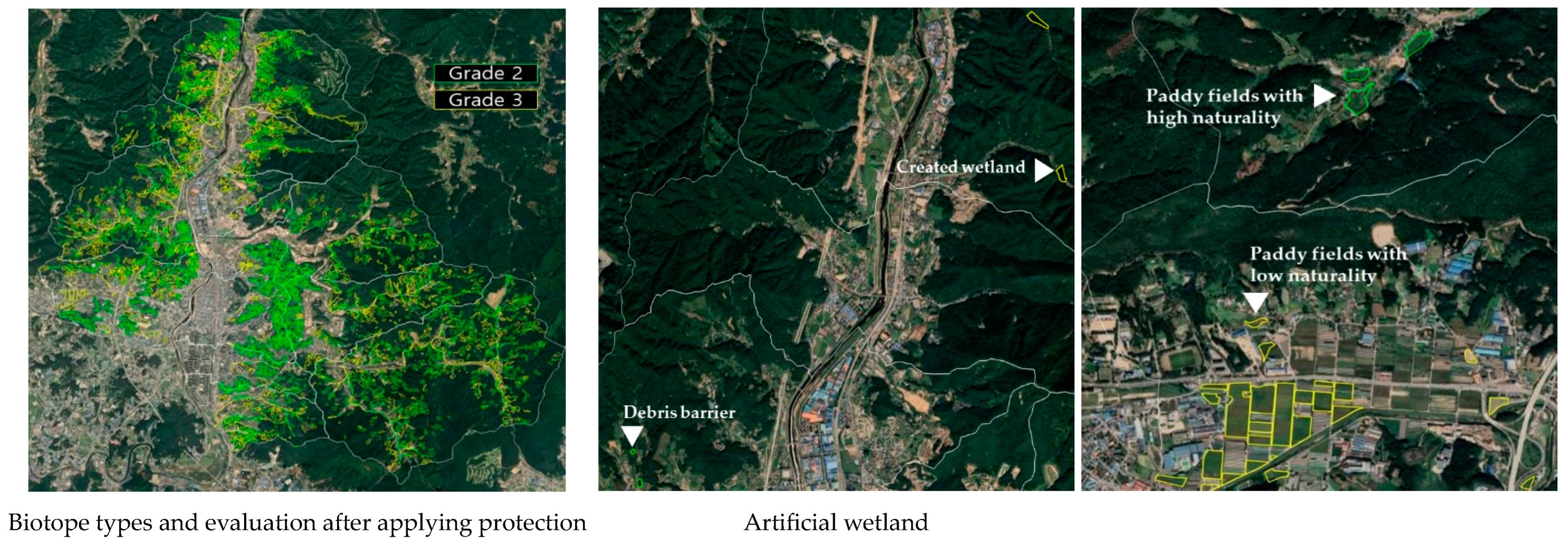

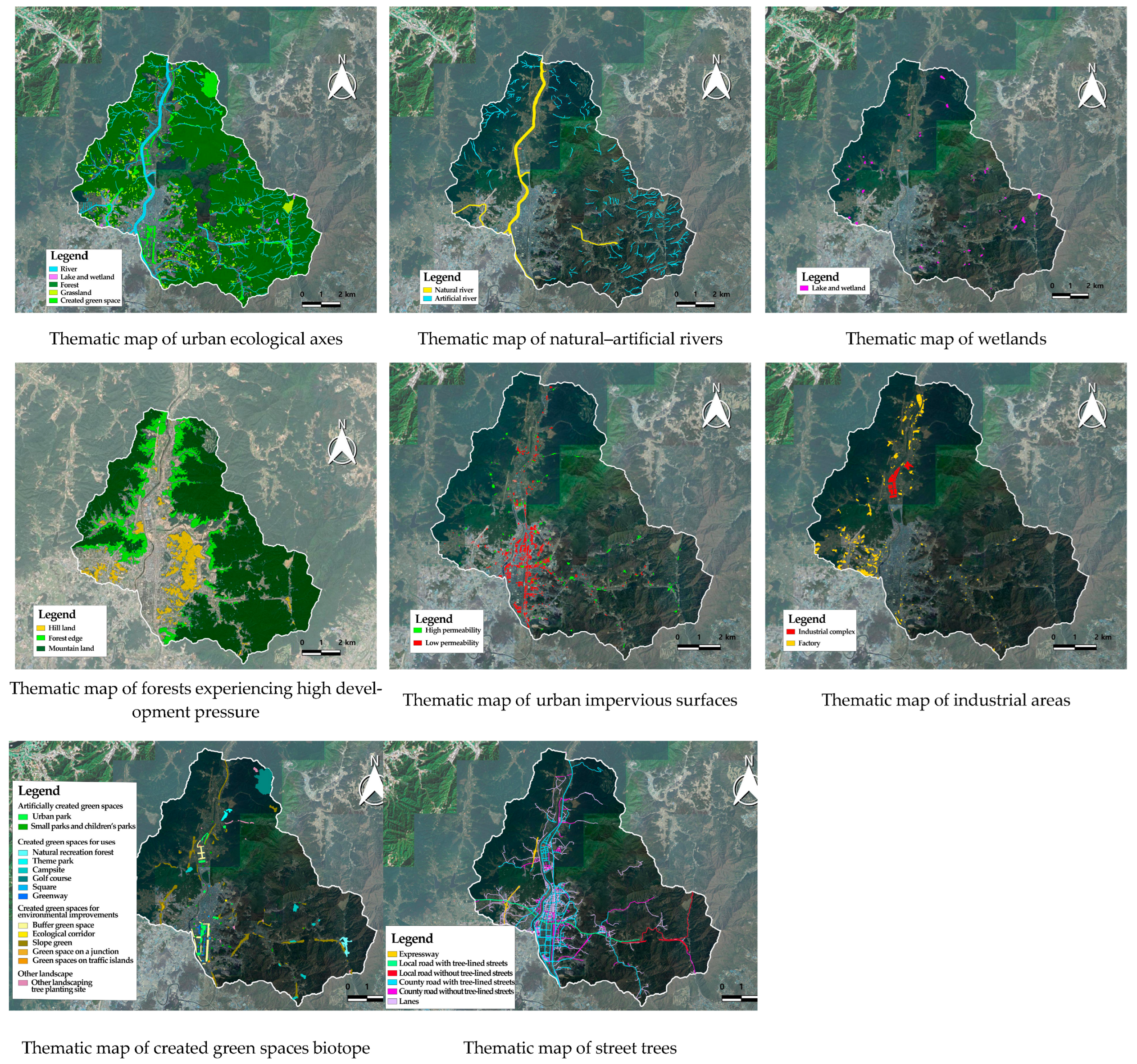
| Study Site | Biotope Map Creation Year | Area | Environmental Characteristics of the City | Meso-Classification Evaluation Sections |
|---|---|---|---|---|
| Siheung | 2020 | 139.9 km2 | Coast-inland, industry-agriculture, high urban density | Meso-classification evaluation grade Ⅰ–Ⅴ |
| Goyang | 2022 | 268.1 km2 | Old town-new town, flatland-mountain, high development of flatland | Meso-classification evaluation grade Ⅰ–Ⅴ |
| Gwangju | 2021 | 431 km2 | industry-agriculture, forest, high development around the forest | Meso-classification evaluation grade Ⅰ–Ⅴ |
| Pyeongtaek | 2021 | 457.9 km2 | Coast-inland, old town-new town, flatland, high development flatland | Meso-classification evaluation grade Ⅰ–Ⅴ |
| Hwaseong | 2021 | 700.6 km2 | Coast-inland, old town-new town, flatland, high development flatland | Meso-classification evaluation grade Ⅰ–Ⅴ |
| Guri | 2022 | 33.3 km2 | Forest-flatland, high urban density | Meso-classification evaluation grade Ⅰ–Ⅴ |
| Biotope Major-Classification Types | Biotope Meso-Classification Types | Biotope Meso-Classification Type Evaluation Grade for Each Site | Average Meso-Classification Type Evaluation Grade | |||||
|---|---|---|---|---|---|---|---|---|
| Siheung [27] | Goyang [28] | Gwangju [29] | Pyeongtaek [30] | Hwaseong [31] | Guri [32] | |||
| Residential area | Urban detached housing | 5 | 5 | 4 | 5 | 5 | 4 | 4.7 |
| Rural detached housing | 4 | 4 | 4 | 4 | 4 | 4 | 4.0 | |
| Low-rise apartment complex | 5 | 5 | 5 | 5 | 5 | 5 | 5.0 | |
| Mid-rise apartment complex | 5 | 5 | 5 | 5 | 5 | 5 | 5.0 | |
| High-rise apartment complex | 5 | 5 | 5 | 5 | 5 | 4 | 4.8 | |
| Commercial and business area | Low-rise commercial business district | 5 | 5 | 5 | 5 | 5 | 5 | 5.0 |
| Mid-rise commercial business district | 5 | 5 | 5 | 5 | 5 | 5 | 5.0 | |
| High-rise commercial business district | 5 | 5 | 5 | 5 | 5.0 | |||
| Mixed residential and business area | Mixed residential and business areas with low-rise buildings | 5 | 5 | 5 | 5 | 5 | 5 | 5.0 |
| Mixed residential and business area with mid-rise buildings | 5 | 5 | 5 | 5 | 5 | 5.0 | ||
| Mixed residential and business areas with high-rise buildings | 5 | 5.0 | ||||||
| Public-use area | Educational institutions | 4 | 4 | 4 | 4 | 4 | 4 | 4.0 |
| Administrative and public institutions | 5 | 5 | 5 | 5 | 5 | 5 | 5.0 | |
| Hospitals and nursing facilities | 5 | 5 | 5 | 5 | 5 | 5 | 5.0 | |
| Large exercise facility site | 5 | 4 | 4 | 4 | 4 | 4 | 4.2 | |
| Religious facility site | 5 | 5 | 5 | 5 | 5 | 5.0 | ||
| Other public-use areas | 4 | 5 | 5 | 5 | 5 | 4.8 | ||
| Industrial area | Large factories | 5 | 5 | 5 | 5.0 | |||
| Small factories | 5 | 5 | 5 | 5 | 5 | 5 | 5.0 | |
| Warehouse | 5 | 5 | 5 | 5 | 5 | 5 | 5.0 | |
| Supply processing facility area | Water-related facility site | 4 | 4 | 5 | 4 | 5 | 5 | 4.5 |
| Waste-related facility site | 5 | 5 | 5 | 5 | 5 | 5 | 5.0 | |
| Energy-related facility site | 4 | 5 | 5 | 5 | 5 | 5 | 4.8 | |
| Communications-related facility site | 5 | 5 | 5.0 | |||||
| Transportation facility area | Road | 5 | 5 | 5 | 5 | 5 | 5 | 5.0 |
| Parking lot | 5 | 5 | 5 | 5 | 5 | 5 | 5.0 | |
| Railroad | 4 | 5 | 5 | 5 | 5 | 5 | 4.8 | |
| Port | 5 | 5 | 5 | 5.0 | ||||
| Transportation-related supplementary facility site | 4 | 5 | 5 | 5 | 5 | 5 | 4.8 | |
| Special area | Construction site | Not evaluated | ||||||
| Open-air storage yard | 5 | 5 | 5 | 5 | 5 | 5.0 | ||
| Site that could not be surveyed | Not evaluated | |||||||
| River | Natural river | 1 | 1.0 | |||||
| Close-to-nature river | 1 | 2 | 2 | 2 | 2 | 2 | 1.8 | |
| Artificial river | 2 | 3 | 3 | 3 | 3 | 3 | 2.8 | |
| Small river | 3 | 3 | 3 | 3 | 3 | 3 | 3.0 | |
| Agricultural waterway | 4 | 4 | 4 | 4 | 3 | 4 | 3.8 | |
| Lake and wetland | Natural wetland | 1 | 1 | 1 | 1 | 1 | 1.0 | |
| Artificial wetland | 2 | 3 | 2 | 3 | 2 | 2 | 2.3 | |
| Coast | Natural coast | 1 | 1 | 1.0 | ||||
| Artificial coast | 3 | 4 | 3.5 | |||||
| Coastal structures | 5 | 5.0 | ||||||
| Forest | Natural forest | 1 | 1 | 1 | 1 | 1.0 | ||
| Natural–artificial forest | 2 | 2 | 2 | 2 | 2 | 2 | 2.0 | |
| Artificial forest | 3 | 2 | 2 | 2 | 2 | 2 | 2.2 | |
| Shrub vegetation area | 3 | 3 | 3 | 3 | 3 | 3.0 | ||
| Deforested and damaged area | 4 | 4.0 | ||||||
| Rock outcrop | 3 | 3.0 | ||||||
| Grassland | Natural grassland | 3 | 3 | 3 | 3 | 3 | 3.0 | |
| Artificial grassland | 3 | 3 | 3 | 3 | 3 | 4 | 3.2 | |
| Farmland | Wet farmland | 3 | 3 | 3 | 3 | 3 | 3.0 | |
| Dry farmland | 4 | 4 | 4 | 4 | 4 | 4 | 4.0 | |
| Facility-type farmland | 5 | 5 | 5 | 5 | 5 | 5 | 5.0 | |
| Created green space | Artificially created park green space | 4 | 3 | 3 | 3 | 3 | 3 | 3.2 |
| Facility-type green space | 4 | 3 | 3 | 3 | 3 | 3 | 3.2 | |
| Bare land andruins | Urban abandoned land | 4 | 5 | 5 | 5 | 5 | 5 | 4.8 |
| Rural abandoned land | 4 | 4.0 | ||||||
| Mining site | 5 | 5 | 5.0 | |||||
| Biotope Meso-Classification Type Evaluation Grade | Biotope Meso-Classification Type | Naturality Categorization |
|---|---|---|
| 1 | Natural river, Natural wetland, Natural coast, Natural forest | Nature |
| 2 | Close-to-nature river, Artificial River, Artificial wetland, Natural–artificial forest, Artificial forest | Near-nature |
| 3 | Small river, Artificial coast, Shrub vegetation area, Rock outcrop, Natural grassland, Artificial grassland, Wet farmland, artificially created park green space, Facility-type green space | |
| 4 | Rural detached housing, Educational institution, Large exercise facility site, Water-related facility site, Agricultural waterway, Deforested and damaged area, Dry farmland, Rural abandoned land | Semi-nature |
| 5 | Urban detached housing, Low-rise apartment complex, Mid-rise apartment complex, High-rise apartment complex, Commercial and business area (Major classification), Mixed residential and business area (Major classification), Administrative and public institutions, Hospitals and nursing facilities, Religious facilities, Other public-use areas, Industrial area (Major classification), Waste-related facility site, Energy-related facility site, Communications-related facility site, Transportation facility area (Major classification), Open-air storage yard, Coastal structures, Facility-type farmland, Urban abandoned land, Mining site |
| Naturality Category | Management Goals | Definition of Terms | |||
|---|---|---|---|---|---|
| Nature | Preservation | Maintenance | Maintain the status quo of biotopes with high ecological potential | ||
| Near-nature | Protection | Protect ecologically sensitive biotopes from surrounding influences | |||
| Restoration | Recovery | Restore damaged or artificially modified biotopes to their previous or similar state | |||
| Semi-nature | Improvement | Improve the ecological quality of current biotope types through ecological management such as extensive vegetation management and induction of transition processes | |||
| Advancement | Creation | Improve the ecological quality of biotope types through the creation of new biotope elements such as the creation of ecological ponds | |||
| Reduction | Pollution source management to safeguard human health and the surrounding environment | ||||
| Naturality Category | Biotope Meso-Classification Type Evaluation Grade | Biotope Meso-Classification Type Evaluation Grade Criteria | Biotope Meso-Classification Type | Management Goals |
|---|---|---|---|---|
| Nature: Areas with value or high potential as biological habitats | 1 | Little or no human intervention; Long-term stable and mature vegetation structure; Declining biotope with high sensitivity to damage; Biotope type whose naturality is so high that alternative creations are impossible; Biotope type with very high biological habitat and ecological network functions; Biotope types with international, national, and regional importance | Natural forest | Maintenance / Protection / Recovery |
| Natural wetland | ||||
| Natural coast | ||||
| Natural river | ||||
| Near-nature: Areas with low-intensity land use | 2 | Declining biotope with human interference and moderate sensitivity to damage; Certain level of naturality and conditional substitution is feasible; Biotope type with high biological habitat and ecological network functions | Close-to-nature river | Protection / Recovery / Improvement / Creation |
| Natural–artificial forest | ||||
| Artificial forest | ||||
| Artificial wetland | ||||
| Artificial river | ||||
| 3 | Biotope with high human interference and low sensitivity to damage; Creation closer to nature from the perspective of natural protection and landscape management; Low naturality requires mid-to-long-term regeneration period; Measures to increase biotope value are required; Biotope type with medium levels of habitat function and ecological network function | Small river | ||
| Shrub vegetation area | ||||
| Rock outcrop | ||||
| Natural grassland | ||||
| Artificial grassland | ||||
| Wet farmland | ||||
| Artificially created park green space | ||||
| Facility-type green space | ||||
| Artificial coast | ||||
| Dry farmland | ||||
| Semi-nature: Areas continuously subject to human interference and influence | 4 | Biotope with very high human interference and little value as a biological habitat; Low naturality and high availability | Agricultural waterway | Improvement / Creation / Reduction |
| Deforested and damaged area | ||||
| Large exercise facility site | ||||
| Rural detached housing | ||||
| Rural abandoned land | ||||
| Facility-type farmland | ||||
| Urban detached housing | ||||
| Other public-use areas | ||||
| Urban abandoned land | ||||
| Mining site | ||||
| 5 | Low naturality and low possibility of natural regeneration due to excessive energy consumption and extensive impervious pavements | Low-rise apartment complex | ||
| Mid-rise apartment complex | ||||
| High-rise apartment complex | ||||
| Educational institution | ||||
| Administrative and public institutions | ||||
| Hospitals and nursing facilities | ||||
| Religious facilities | ||||
| Commercial and business area (Major classification) | ||||
| Mixed residential and business area (Major classification) | ||||
| Coastal structures | ||||
| Urban abandoned land | ||||
| Industrial area (Major classification) | ||||
| Waste-related facility site | ||||
| Energy-related facility site | ||||
| Communications-related facility site | ||||
| Water-related facility site | ||||
| Transportation facility area (Major classification) | ||||
| Open-air storage yard |
| Field | Research Participants | Description | Interview Method | Interview Time |
|---|---|---|---|---|
| Plant | Botanical taxonomist with minimum 5 years of experience: 2 persons PhD in plant field: 2 persons | 1st:
Second:
| In-person, written, and phone interviews | In-person: 1 h Written: e-mail recovery 10 days after sending it Phone: additional questions |
| Animal | Zoological taxonomist with minimum 5 years of experience: 2 persons Ph.D. in animal field: 2 persons | |||
| Ecological restoration | Natural ecological restoration engineer with minimum 5 years of experience: 2 persons Natural environment management engineer, environmental impact assessor: 2 persons | |||
| Landscape | Landscape architect with minimum 5 years of experience: 1 person Ph. D. in landscape architecture: 1 person | |||
| Urban planning | Urban planning specialist with minimum 5 years of experience: 1 person |
| Naturality Category | Biotope Meso-Classification Type | Management Goals | Biotope Minor-Classification Type Evaluation Item | Reconfiguration of Minor-Classification Type Evaluation Indicators for Target Sites |
|---|---|---|---|---|
| Nature | Grade 1 Natural forest Natural wetland Natural coast Natural river | Maintenance | Naturality | International importance (migratory bird habitat), national importance (legally protected area, vegetation area with extreme climate), regional importance (wildlife habitat) |
| Protection | Naturality | Naturality of vegetation, naturality of dominant species, naturality of rivers | ||
| Rarity | Preservation of the community with value, rare habitat, legally protected species habitat, biotope area ratio, number of biotopes | |||
| Connectivity | Forest size, river size, wetland size, proximity to forest and water source, density of core ecological axis | |||
| Recovery | Recuperative ability | Stability of the community (similarity between the tree layer and low-tree layer), average age of vegetation, average diameter at breast height of vegetation, possibility of forest erosion, development level of organic matter layer | ||
| Diversity | Forest basin area (mountainous stream), forest type, habitat characteristics, stratified structure, presence of river flow, open surface of wetland | |||
| Vulnerability | Proximity to hiking trails, proximity to roads, hydrological control in wetlands, rate of contact with disturbed patches, possibility of landslides, areas of pests and diseases, terrain damage, status of artificial management after damage (land treated for erosion control), spread possibility of invasive species | |||
| Near- nature | Grades 2–3 Close-to-nature river Natural–artificial forest Artificial forest Artificial wetland Artificial river Small river Shrub vegetation area Rock outcrop Natural grassland Artificial grassland Wet farmland Dry farmland Artificially created park green space Facility-type green space Artificial coast | Protection | Rarity | Historical value (cultural heritage planting site), legally protected species habitat, biotope area ratio, and number of biotopes |
| Connectivity | Forest size, river size, wetland size, proximity to forest and water source, density of core ecological axis | |||
| Restoration | Recuperative ability | Age class, breast height, naturality of dominant species, naturality of late-successional species | ||
| Diversity | Forest floor type, habitat characteristics, stratified structure, river size, presence or absence of aquatic spaces in the river bank, wetland size, and development level of organic matter layer | |||
| Vulnerability | Distance from hiking trails, distance from road, management intensity, spread possibility of invasive species | |||
| Improvement | Ecological functionality | Biotope area, forest and stream separation distance, elevation, slope | ||
| Risk of damage | Location, pervious pavement ratio, floor pavement material | |||
| Creation | Potential as habitats | Green area ratio, stratified structure, vegetation cover ratio, presence or absence of rice paddy land readjustment, size of rice paddies, size of parks, pervious pavement ratio, tree crown cover, location, topographic conditions, movement of wild animals, ecological axis connectivity, green space connectivity, vegetation characteristics, green space width, habitat characteristics, impervious pavement ratio, growth base, possibility of amphibian road kill, habitat features (cutting and fill-up), adjacency to road, adjacency to ecological axis and buffer function, distance to urbanized areas | ||
| Availability | Cultural function, popular function, recreational function | |||
| Semi- nature | Grades 4–5 Agricultural waterway Deforested and damaged area Large exercise facility site Rural detached housing Rural abandoned land Facility-type farmland Urban detached housing Other public-use areas Urban abandoned land Mining site Facility-type farmland Low-rise apartment complex Mid-rise apartment complex High-rise apartment complex Educational institution Administrative and public institutions Hospitals and nursing facilities Religious facilities Commercial and business area (Major classification) Mixed residential and business area (Major classification) Coastal structures Urban abandoned land Industrial area (Major classification) Waste-related facility site Energy-related facility site Communications-related facility site Water-related facility site Transportation facility area (Major classification) Open-air storage yard | Improvement | Ecological functionality | Biotope area, wildlife movement function |
| Risk of damage | Location, management intensity, use intensity, artificial topography (non-compartment and compartment), rural landscape ratio, agricultural waterway maintenance type | |||
| Creation | Potential as habitats | Green area ratio, stratified structure, vegetation cover ratio, pervious pavement ratio, playground pavement material, tree crown cover, presence or absence of retention, presence or absence of wetlands, vegetation characteristics, road adjacency, ecological axis adjacency, and buffer function | ||
| Availability | Historical value, cultural function, popular function, recreational function | |||
| Urban environment improvement functionality | Green space ratio, Impervious pavement ratio, Pervious pavement ratio | |||
| Reduction | Urban environment improvement functionality | Green area ratio, impervious pavement ratio, pervious pavement ratio, building height, building-to-land ratio, presence or absence of street green space (trees + shrubs), presence or absence of street trees, type of street tree arrangement, presence or absence of median strip of green space, pavement material, average diameter at breast height, presence of ground parking lot, adjacency to forest, proximity per type of created green spaces, adjacency to park green spaces, green roof area, presence of vegetation, tree crown cover, green building certification, particular matter emissions |
| Naturality Category | Management Goals | Biotope Meso-Classification Type | Meso-Classification Type Evaluation Grade | Biotope Minor-Classification Type Evaluation Items | Minor- Classification Grade |
|---|---|---|---|---|---|
| Nature | Maintenance | Natural river, Natural forest | I(1) | Naturality | I(1) |
| II(2) | |||||
| Protection | Natural wetland, Artificial wetland | Rarity, Connectivity | II(2) | ||
| III(3) | |||||
| Near- nature | Protection | Small river, Natural–artificial forest, Artificial–Natural forest *, Mountain forests *, Hill land *, Wet farmland | II(2) | Naturality, Rarity, ecological axis (Connectivity) | II(2) |
| III(3) | |||||
| Recovery | Artificial river | Vulnerability | III(3) | ||
| IV(4) | |||||
| Recovery | Artificial forest, Shrub vegetation area, Rock outcrop, Secondary grassland (Natural grassland) | III(3) | Recuperative ability | III(3) | |
| IV(4) | |||||
| Improvement | Artificial grassland, Dry farmland, Urban parks (Artificially created park green space), Small parks and children’s parks (Artificially created park green space) | Ecological functionality | IV(4) | ||
| V(5) | |||||
| Semi- nature | Improvement | Agricultural waterway, Deforested and damaged area, Created green spaces for uses *, Created green spaces for environmental improvements *, Other landscaping tree planting sites * | IV(4) | Ecological functionality, Risk of damage | IV(4) |
| V(5) | |||||
| Creation | Urban detached housing, Rural detached housing, Exercise facility site, Other public-use areas, Urban abandoned land, Rural abandoned land, Facility-type farmland, Mining site | Urban-environmental function, Availability, Potential as habitats | V(5) | ||
| VI(6) | |||||
| Creation | Low-rise apartment complexes, Mid-rise apartment complexes, High-rise apartment complexes, Low-rise commercial business districts, Mid-rise commercial business districts, Mixed residential and business areas with low-rise buildings, Educational institutions, Administrative and public institutions, Hospitals and nursing facilities, Religious facilities | V(5) | Urban-environmental function, Availability | V(5) | |
| VI(6) | |||||
| Reduction | Small factories, Water-related facility sites, Energy-related facility sites, Road, Parking lots, Railroad, Transportation-related supplementary facility sites, Primary forest road *, Open-air storage yard | Urban-environmental function | VI(6) | ||
| VII(7) |
| Grade | Area (m2) | Percentage (%) |
|---|---|---|
| I(1) | 29,920,033.6 | 31.27 |
| II(2) | 11,687,563.9 | 12.22 |
| III(3) | 16,454,464.1 | 17.20 |
| IV(4) | 12,342,063.0 | 12.90 |
| V(5) | 5,364,863.6 | 5.61 |
| VI(6) | 7,307,668.4 | 7.64 |
| VII(7) | 3,445,086.1 | 3.60 |
| Non-evaluation (special sites) | 9,146,204.6 | 9.56 |
| Total | 95,667,947.2 | 100.00 |
| Biotope Meso- Classification Type | Meso-Classification Type Evaluation Grade | Management Goals | Biotope Minor-Classification Type | Evaluation Item | Evaluation Indicator | Evaluation Criteria | Minor- Classification Type Evaluation Grade |
|---|---|---|---|---|---|---|---|
| Small factory | V(5) | Reduction | Industrial complex | Urban-environmental function | Pollution purification facility | Presence | VI(6) |
| Factory | Absence | VII(7) | |||||
| Water-related facility site | V(5) | Reduction | Water supply facilities | - | - | - | VII(7) |
| Sewage treatment plant | - | VII(7) | |||||
| Rainwater pumping station | - | VII(7) | |||||
| Energy-related facility site | V(5) | Reduction | Energy-related facilities | - | - | - | VII(7) |
| Road | V(5) | Reduction | Expressway | Urban-environmental function | Presence or absence of street trees | Absence | VII(7) |
| Local road with tree-lined streets | Presence | VI(6) | |||||
| Local road without tree-lined streets | Absence | VII(7) | |||||
| City road with tree-lined streets | Presence | VII(6) | |||||
| City road without tree-lined streets | Absence | VII(7) | |||||
| Lanes | Absence | VII(7) | |||||
| Parking lot | V(5) | Reduction | Pervious parking lot | Urban-environmental function | Pavement material | Pervious pavement | VI(6) |
| Impervious parking lot | Impervious pavement | VII(7) | |||||
| Railroad | V(5) | Reduction | Railway | Urban-environmental function | Presence or absence of landscape green space | Absence | VII(7) |
| Station | Presence | VI(6) | |||||
| Transportation-related supplementary facility site | V(5) | Reduction | Transportation-related supplementary facility site | - | - | - | VII(7) |
| Primary forest road | V(5) | Reduction | Unpaved primary forest road | Urban-environmental function | Status of being paved | Unpaved | V(5) |
| Paved primary forest road | Paved | VI(6) | |||||
| Open-air storage yard | V(5) | Reduction | Open-air storage yard and junk shop | - | - | - | VII(7) |
| Biotope Meso- Classification Type | Meso-Classification Type Evaluation Grade | Management Goals | Biotope Minor-Classification Type | Evaluation Item | Evaluation Indicator | Evaluation Criteria | Minor- Classification Type Evaluation Grade |
|---|---|---|---|---|---|---|---|
| Urban detached housing | IV(4) | Creation | Urban detached housing with high permeability | Urban-environmental function | Permeability | >25% | V(5) |
| Urban detached housing with low permeability | <25% | VI(6) | |||||
| Rural detached housing | IV(4) | Creation | Rural detached housing | Availability | Absence/presence of gardens | Absence | VI(6) |
| Countryside housing site | Presence | V(5) | |||||
| Countryside housing complex | Presence | V(5) | |||||
| Low-rise apartment complex | V(5) | Creation | Low-rise apartment complex with high permeability | Urban-environmental function | Permeability | >20% | V(5) |
| Low-rise apartment complex with low permeability | <20% | VI(6) | |||||
| Mid-rise apartment complex | V(5) | Creation | Mid-rise apartment complex with high permeability | Urban-environmental function | Permeability | >10% | V(5) |
| Mid-rise apartment complex with low permeability | <10% | VI(6) | |||||
| High-rise apartment complex | V(5) | Creation | High-rise apartment complex | - | - | - | V(5) |
| Low-rise commercial business district | V(5) | Creation | Low-rise commercial business district with high permeability | Urban-environmental function | Permeability | >25% | V(5) |
| Low-rise commercial business district with low permeability | <25% | VI(6) | |||||
| Mid-rise commercial business district | V(5) | Creation | Mid-rise commercial business district with high permeability | Urban-environmental function | Permeability | >10% | V(5) |
| Mid-rise commercial business district with low permeability | Less than 10% | VI(6) | |||||
| Mixed residential and business areas with low-rise buildings | V(5) | Creation | Mixed residential and business areas with low-rise buildings | - | - | - | VI(6) |
| Educational institution | V(5) | Creation | University | Availability | Provision of open spaces | Presence | V(5) |
| Elementary, middle, and high school | Absence | VI(6) | |||||
| Nursery | Absence | VI(6) | |||||
| Administrative and public institutions | V(5) | Creation | Administrative and public institutions | - | - | - | VI(6) |
| Hospitals and nursing facilities | V(5) | Creation | Hospitals and nursing facilities | - | - | - | VI(6) |
| Exercise facility site | IV(4) | Creation | Large exercise facility site | Availability | Green areas | Large scale | V(5) |
| Small exercise facility site | Small scale | VI(6) | |||||
| Religious facilities | V(5) | Creation | Religious facility site with high permeability | Urban-environmental function | permeability | >30% | V(5) |
| Religious facility site with low permeability | <30% | VI(6) | |||||
| Other public-use areas | IV(4) | Creation | Cultural facilities | Availability | Cultural function | Presence | V(5) |
| Senior center and village hall | Absence | VI(6) | |||||
| Factory | Absence | VII(7) |
| Biotope Meso- Classification Type | Meso-Classification Type Evaluation Grade | Management Goals | Biotope Minor-Classification Type | Evaluation Item | Evaluation Indicator | Evaluation Criteria | Minor- Classification Type Evaluation Grade |
|---|---|---|---|---|---|---|---|
| Facility-type farmland | IV(4) | Creation | Vinyl greenhouse | Risk of damage | Pollutant emission | Low | V(5) |
| Stockyard | High | VI(6) | |||||
| Urban abandoned land | IV(4) | Creation | Abandoned land with low development potential | Potential habitat | Use area | Green area/Preservation management | V(5) |
| Abandoned land with high development potential | Residential, commercial, industrial, production, planning management | VI(6) | |||||
| Rural abandoned land | IV(4) | Creation | Abandoned land with woody plants | Potential habitat | Absence and presence of woody plants | Presence | V(5) |
| Abandoned land without woody plants | Absence | VI(6) | |||||
| Mining site | IV(4) | Creation | Quarry | - | - | - | VI(6) |
| Biotope Meso- Classification Type | Meso-Classification Type Evaluation Grade | Management Goals | Biotope Minor-Classification Type | Evaluation Item | Evaluation Indicator | Evaluation Criteria | Minor- Classification Type Evaluation Grade |
|---|---|---|---|---|---|---|---|
| Agricultural waterway | IV(4) | Improvement | Ditch | - | - | - | V(5) |
| Deforested and damaged area | IV(4) | Improvement | Logging area | - | - | - | IV(4) |
| Artificial grassland | III(3) | Improvement | Large cemetery | Ecological functionality | Damage to the topography | Compartment | V(5) |
| Small cemetery | Non- compartment | IV(4) | |||||
| Dry farmland | III(3) | Improvement | Tree planting site | - | - | - | IV(4) |
| Upland fields | - | IV(4) | |||||
| Orchard | - | IV(4) | |||||
| Artificially created park green space | III(3) | Improvement | Urban parks | Ecological functionality | Size | >6500 m2 | IV(4) |
| Small parks and children’s parks | <6500 m2 | V(5) | |||||
| Created green spaces for uses | IV(4) | Improvement | Natural recreation forest | Risk of damage | Use intensity | Low | IV(4) |
| Theme park | Low | IV(4) | |||||
| Campsite | High | V(5) | |||||
| Golf course | High | V(5) | |||||
| Square | High | V(5) | |||||
| Greenway | High | V(5) | |||||
| Created green spaces for environmental enhancement | IV(4) | Improvement | Buffer green space | Risk of damage | Location | Outside Road | IV(4) |
| Ecological corridor | Ecological functionality | Movement of wild animals | Presence | IV(4) | |||
| Slope green | Risk of damage | Location | Outside Road | IV(4) | |||
| Green space on a junction | Within Road | V(5) | |||||
| Green spaces on traffic islands | Within Road | V(5) | |||||
| Other landscape | IV(4) | Improvement | Other landscaping tree planting site | - | - | - | V(5) |
| Biotope Meso- Classification Type | Meso-Classification Type Evaluation Grade | Management Goals | Biotope Minor-Classification Type | Evaluation Item | Evaluation Indicator | Evaluation Criteria | Minor- Classification Type Evaluation Grade |
|---|---|---|---|---|---|---|---|
| Artificial river | II(2) | Recovery | Water surface of artificial river | Vulnerability | Artificial management strength | Low | III(3) |
| Natural green space in the artificial river | Low | III(3) | |||||
| Created green space in the artificial river | High | IV(4) | |||||
| Facility site in the artificial river | High | IV(4) | |||||
| Bridge substructures in the artificial river | High | IV(4) | |||||
| Artificial forest | III(3) | Recovery | Artificial forest with native species | Recuperative ability | Autogenous dominant species | Native | III(3) |
| Artificial forest with non-native species | Non-native | IV(4) | |||||
| Shrub vegetation area | III(3) | Recovery | Valley shrub forest | Recuperative ability | Naturality of vegetation | Natural | III(3) |
| Shrub vegetation in rocky land | Natural | III(3) | |||||
| Secondary shrub forest | Natural | III(3) | |||||
| Artificial shrub forest | Artificial | IV(4) | |||||
| Rock outcrop | III(3) | Recovery | Talus slope | - | - | - | IV(4) |
| Secondary grassland | III(3) | Recovery | Secondary grassland | - | - | - | IV(4) |
| Biotope meso- Classification Type | Meso-Classification Type Evaluation Grade | Management Goals | Biotope Minor-Classification Type | Evaluation Item | Evaluation Indicator | Evaluation Criteria | Minor- Classification Type Evaluation Grade |
|---|---|---|---|---|---|---|---|
| Small river | II(2) | Protection | Small river adjacent to the mountainous area | Naturality | Naturality of rivers | Natural type | II(2) |
| Natural small river | Natural type | II(2) | |||||
| Artificial small rive | Artificial type | III(3) | |||||
| Small river for uses | Artificial type | III(3) | |||||
| Small river in land treated for erosion control | Artificial type | III(3) | |||||
| Natural wetland | I(1) | Protection | Natural wetland | Rarity | Number of polygons | - | II(2) |
| Abandoned paddy | - | II(2) | |||||
| Doombung | - | II(2) | |||||
| Artificial wetland | I(1) | Protection | Debris barrier | Connectivity | Hydrological control | Weir | III(3) |
| Created wetland | No weir | II(2) | |||||
| Natural-artificial forest | II(2) | Protection | Natural–artificial Forest | Naturality | Naturality of dominant species | Natural–Artificial | II(2) |
| Artificial–natural forest | Artificial–Natural | III(3) | |||||
| Mountain forests | II(2) | Protection | Wet forest in mountainous forests | Rarity | Rare habitat | Wet forest | II(2) |
| Forests with dominant natural vegetation on wet soils | Naturality | Naturality of vegetation | Natural | II(2) | |||
| Forests with dominant natural vegetation on dry soils | Natural | II(2) | |||||
| Forests with dominant artificial vegetation on wet soils | Artificial | III(3) | |||||
| Forests with dominant artificial vegetation on dry soils | Artificial | III(3) | |||||
| Hill land | II(2) | Protection | Wet forest on hill land | Rarity | Rare habitat | Wet forest | II(2) |
| Forest dominated by natural vegetation distributed over large hill lands (>10 ha) | Ecological axis | Forest size | Large | II(2) | |||
| Forest dominated by artificial vegetation distributed over large hill lands (>10 ha) | Large | II(2) | |||||
| Forest dominated by natural vegetation distributed over small hill lands (<10 ha) | Small | III(3) | |||||
| Forest dominated by artificial vegetation distributed over small hill lands (<10 ha) | Small | III(3) | |||||
| Wet farmland | II(2) | Protection | Paddy fields with high naturality | Rarity | Absence and presence of readjustment of arable land | No readjustment of arable land | II(2) |
| Paddy fields with low naturality | Readjustment of arable land | III(3) |
| Biotope Meso- Classification Type | Meso-Classification Type Evaluation Grade | Management Goals | Biotope Minor-Classification Type | Evaluation Item | Evaluation Indicator | Evaluation Criteria | Minor- Classification Type Evaluation Grade |
|---|---|---|---|---|---|---|---|
| Natural river | I(1) | Maintenance | Mountainous stream | Naturality | Absence and presence of erosion control work | Absence | I(1) |
| Mountainous streams in land treated for erosion control | Presence | II(2) | |||||
| Natural forest | I(1) | Maintenance | Mountain wet forest | - | - | - | I(1) |
| Mountain broadleaf forest with wet soil | - | I(1) | |||||
| Mountain broadleaf forest with dry soil | - | I(1) | |||||
| Mixed forest of soft and hardwood with wet soil | - | I(1) | |||||
| Mixed forest of soft and hardwood with dry soil | - | I(1) | |||||
| Mountain coniferous forest with wet soil | - | I(1) | |||||
| Mountain coniferous forest with dry soil | - | I(1) |
| Evaluation Grade | Description |
|---|---|
| I(1) |
|
| II(2) |
|
| III(3) |
|
| IV(4) |
|
| V(5) |
|
Disclaimer/Publisher’s Note: The statements, opinions and data contained in all publications are solely those of the individual author(s) and contributor(s) and not of MDPI and/or the editor(s). MDPI and/or the editor(s) disclaim responsibility for any injury to people or property resulting from any ideas, methods, instructions or products referred to in the content. |
© 2024 by the authors. Licensee MDPI, Basel, Switzerland. This article is an open access article distributed under the terms and conditions of the Creative Commons Attribution (CC BY) license (https://creativecommons.org/licenses/by/4.0/).
Share and Cite
Kim, T.; Kim, G. Biotope Map Creation Method and Utilization Plan for Eco-Friendly Urban Development. Land 2024, 13, 699. https://doi.org/10.3390/land13050699
Kim T, Kim G. Biotope Map Creation Method and Utilization Plan for Eco-Friendly Urban Development. Land. 2024; 13(5):699. https://doi.org/10.3390/land13050699
Chicago/Turabian StyleKim, Taehun, and Gunwoo Kim. 2024. "Biotope Map Creation Method and Utilization Plan for Eco-Friendly Urban Development" Land 13, no. 5: 699. https://doi.org/10.3390/land13050699
APA StyleKim, T., & Kim, G. (2024). Biotope Map Creation Method and Utilization Plan for Eco-Friendly Urban Development. Land, 13(5), 699. https://doi.org/10.3390/land13050699







